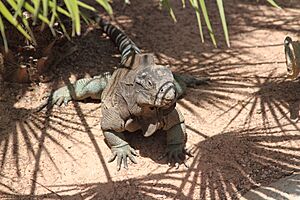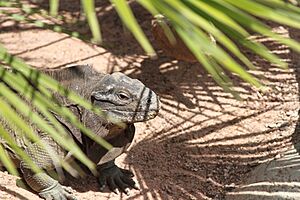Cyclura cychlura figginsi facts for kids
Quick facts for kids Cyclura cychlura figginsi |
|
|---|---|
 |
|
| Exuma Island iguana | |
| Conservation status | |
| Scientific classification |
|
| Kingdom: | Animalia |
| Phylum: | Chordata |
| Class: | Reptilia |
| Order: | Squamata |
| Suborder: | Iguania |
| Family: | Iguanidae |
| Genus: | Cyclura |
| Species: | |
| Subspecies: |
C. c. figginsi
|
| Trinomial name | |
| Cyclura cychlura figginsi Barbour, 1923
|
|
| Synonyms | |
|
|
The Exuma Island iguana (scientific name: Cyclura cychlura figginsi) is a special kind of iguana. People sometimes call it the guana. It lives only on the Exuma islands in the Bahamas. This iguana is a subspecies of the northern Bahamian rock iguana.
In 2004, there were about 1,300 of these iguanas left in the wild. Because of its low numbers, the Exuma Island iguana is listed as critically endangered. This means it is at a very high risk of disappearing forever.
Contents
About the Exuma Island Iguana
What's in a Name?
The Exuma Island iguana's scientific name is Cyclura cychlura figginsi. It is a subspecies of the northern Bahamian rock iguana. The name figginsi was given to honor an American biologist named J. D. Figgins.
In 1923, a scientist named Thomas Barbour officially named this iguana. Later, other scientists decided it was a special type of the northern Bahamian rock iguana.
What Does It Look Like?

These iguanas can grow to be about 1 meter (3 feet) long. Their bodies are dark gray to black. Their heads and snouts can have white or orange scales. The exact colors depend on which island they come from.
Male iguanas are usually bigger than female iguanas. This difference in size between males and females is called sexual dimorphism.
Where Do They Live?
The Exuma Island iguana lives only in the Exuma Cays. These are a chain of islands in the Bahamas. You can find them on at least seven small islands. These include Bitter Guana Cay, Gaulin Cay, and Leaf Cay. In 2002, some iguanas from Leaf Cay were moved to Pasture Cay. This was done to help protect them.
Iguana Life and Habits
Their Home Environment
These iguanas live in different kinds of places. They can be found on sandy beaches. They also live in dry, rocky areas with little plant life. Some even live in Bahamian dry forests.
At night, or when the weather is bad, they hide. They use cracks in rocks or burrows they dig in the sand. These spots keep them safe and warm.
How They Behave
Exuma Island iguanas are quite calm with each other. They do not fight over land or show who is in charge. Adult iguanas often sit together in large groups. They do not show any signs of aggression.
Scientists think this helps them live closely together. It means more iguanas can share limited food and nesting spots. In zoos, one Exuma Island iguana lived for over 23 years.
What Do They Eat?
Like most Cyclura iguanas, the Exuma Island iguana mainly eats plants. They munch on leaves, flowers, berries, and fruits. They eat from over 100 different plant types.
Some of their favorite plants include seaside rock shrub and darling plum. They also enjoy seagrape and silver thatch palm. Interestingly, they also eat the droppings (poop) of certain birds. This helps them get extra nutrients.
How They Have Babies
Mating season for these iguanas is usually in May. The female iguanas then lay their eggs in June or July. They dig nests in the sand for their eggs.
A female usually lays about three eggs. She will guard her nest until the eggs are laid. After that, she leaves the nest.
Protecting the Exuma Island Iguana
Why They Are Endangered
The Exuma Island iguana is in serious trouble. In 2004, there were fewer than 1,300 of them left. Their numbers have dropped by at least 20% in the last 50 years. This is why they are listed as critically endangered.
What Harms Them?
Many things threaten these iguanas. Their homes are shrinking because of new buildings for tourism. In 2004, a big fire on an iguana island was possibly started by a tourist's cigarette.
Sometimes, people try to illegally take these iguanas from their homes. Wild pigs can also be a problem. They dig up and eat the iguana eggs. Wild dogs hunt and eat both young and adult iguanas.
Helping Them Recover
The Bahamas government protects these iguanas. This is done under the Wild Animals Protection Act of 1968.
Since 1995, the Shedd Aquarium has been helping. Volunteers can join trips to count the iguanas. Shedd Aquarium also has programs to breed these iguanas. They breed them both in zoos and in their natural habitat. In 2002, Shedd Aquarium moved 16 iguanas to a protected park. This was done to help create a new safe population.
The Bahamian Government does not have its own official breeding program for the Exuma Island iguana.


